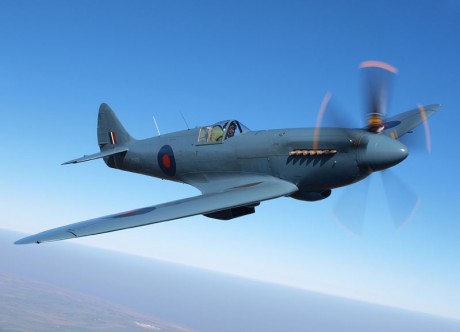
Posted on 06/02/2013 1:37:47 AM PDT by sukhoi-30mki
Spitfire vs Bf 109 and F-14 vs Su-27: the difference is always the pilot
May 31, 2013
Not always the best aircraft is the one that wins in an air-to-air engagement.
Most of the times it is the training the pilot has received and his/her skills, experience to make the difference: that’s why a well trained pilot with a less capable aircraft can defeat a more powerful plane piloted by a scarcely trained airman.
During World War II two of the most successful fighters of aviation history faced one against the other, in a duel that began over the coasts of Dunkirk and ended on the last days of the war: this two aircraft were the legendary Supermarine Spitfire and its German counterpart, the formidable Messerschmitt Bf 109.

Image credit: RAF BBMF
During the dogfights that raged in the skies several examples of both planes fell into the hands of the opponents giving both the Royal Air Force and the Luftwaffe, the opportunity to test the enemy plane.
The first intact Spitfire Mk I was captured by the Germans during the Dunkirk evacuation and immediately used by the Germans against Bf 109E in mock aerial combat.
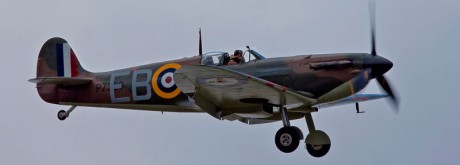
The Spitfire, that was test flown by Maj Werner Mölders in persons, which was at the time the leading ace of the Luftwaffe with 25 aerial victories, was fitted with the old two-speed propeller and had a rate of climb inferior to that of the Spitfire Mk I fitted with the constant-speed propeller.
However German pilots discovered that if the pilot pushed down the nose of the Spitfire and applied negative “G”, the carburetor float of the Merlin engine stopped to deliver fuel with the result that the engine cut out.
On the contrary, the Bf 109E did not suffer from the same problem since his Daimler Benz DB 601 was fitted with the fuel injection system. Due to this defect, Mölders thought that, even if the Spitfire had general performance approaching that of the Bf 109, it was not that good as a fighter.
A Messerschmitt was captured intact by the RAF in November 1939, when a Bf 109E was forced down in France and taken to Farnborough for test flights against the Spitfire Mk I.
The results of the test showed that Reginald Mitchell’s fighter at altitudes around 4,000 feet was far superior to the Messerschmitt Me 109E: but the captured Messerschmitt had problems with the engine cooling system and it could not prove its ability to out-climb the Spitfire at most altitudes.
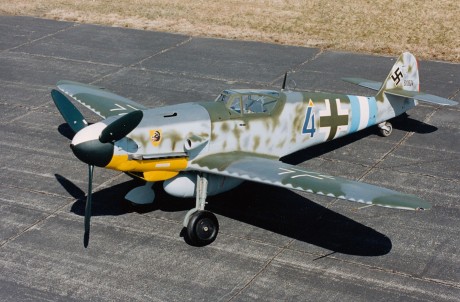
Image credit: USAF
So the British discovered that the Spitfire was better at medium altitude in a turning fight, while the Germans that the Bf 109E was better at high altitude in a high speed combat.
But those trials were valid only up to a point because when these two variants of the fighters faced one against the other was during the air battle over Britain, where the dogfights took place at altitudes between 13,000 and 20,000 feet, the altitude where the escorts for the German bombers were flown: at that height the performance of the two fighters were much closer.
However during the Battle of Britain the German fighters had a slightly advantage due to the high level of training of Luftwaffe pilots: in fact most of them, along with Mölders or Adolf Galland, were extraordinaire pilots who had gained significant experience flying with the Condor Legion during the Spanish Civil War. On the contrary the British pilots were less experienced but they flew in the skies above of their country and they fought to defend it: these two reasons, along with some strategic German mistakes, gave them a lot of motivations and brought the air duels on the same level.
During the war many other variants of these two fighters fell in the hands of each opponents, but another test was conducted early in 1944 by the RAF at Duxford. In 1944 the latest subtype of the Messerschmitt was the Bf 109G (the latest variant of the Bf 109 was the K, but it was built in small numbers and developed too late to play an important role during the war) and one of this kind of Bf 109 was tried against the new and more potent Spitfire Mk XIV powered with the Griffon 61 engine.
The result was that the Spitfire was faster than the Bf 109G at all heights, the rate of climb was the same for the two aircraft around 16,000 feet, while at the other altitudes the Spitfire Mk XIV exceeded the Bf 109G.
50 years later, in the midst of the 1990s, the technology changed the way in which the fighters fought, Air to air combat was still an important part of the training for every pilot of any air force and it is still the better way to understand how an aircraft can perform against those of their counterparts.
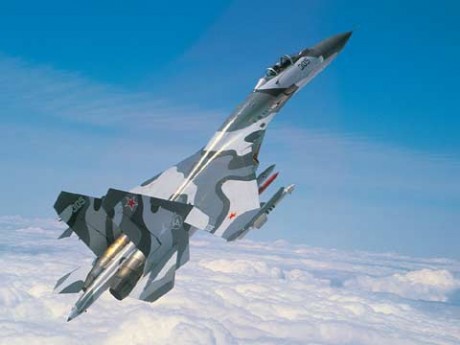
Image credit: Sukhoi
During the last decade of the twentieth century one of the deadliest adversary for the western air forces was the Sukhoi Su-27 Flanker.
The Su-27 belongs to the same class of the US F-14 and F-15, but unlike the American fighters it can fly at an angle of attack of 30 degrees and can also perform the “Pugachev Cobra”, an aerobatic maneuver in which the aircraft pitches the nose beyond the vertical at a rate of 70 degrees per second and after that recovers to level flight. Thanks to this maneuver, the Flanker has been the highlight of every air shows from the end of the 80s to the middle of the 90s.
On 20 April this year an article written by Dave Majumdar for Flightglobal DEW Line, talk about Gerry Gallop, a former TOP GUN instructor and an experienced US Navy pilot who flown F-4, F-14A and B, F-15, F-16, F-18 (both Legacy and Super Hornet) and also A-4.
Once Gallop ended its career he became senior vice president and chief operating of Tactical Air Support, a private operator which operated the Su-27 for short time and during this period he had the chance to fly the Flanker.
During one of his sorties over the Ukraine, Gallop was very impressed by the acceleration and by how fast was the Russian fighter at high altitude. The power of its engines, along with its superb aerodynamics and with short range IR missile AA-11 Archer (which in the ‘90s was the best short-range AAM in the world that can be linked to the pilot’s helmet fire control system and is capable to be fired at targets until 45 degrees off the axis of the aircraft: both these capabilities were not possessed by the AIM-9M Sidewinder, the main western short range missile at the time) made of the Su-27 probably the best dogfighter of the 90s, a very tough adversary for every western jet.
When strictly compared to the F-14, the Tomcat is not less fast than the Su -27, but for the American fighter the Flanker is more than a match in a close combat. In fact, against a more maneuverable fighter like the Su-27, the Tomcat is disadvantaged even if the F-14 is a B or a D model powered with the extremely potent General Electric F110-GE-400 engines.
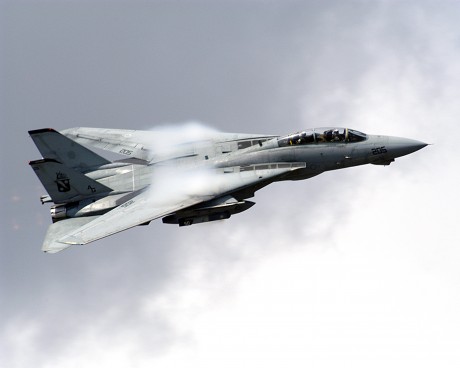
Image credit: U.S. Navy
Sometimes the advantage of an agile adversary can be reduced thanks to the presence of a well trained backseater, but the Tomcat gives the best of itself on long distances where the AIM-54C Phoenix can be used. As explained by some Tomcat drivers, it doesn’t matter how a more agile fighter can get a F-14 in a dogfight, because thanks to Tomcat’s combination of tactics, sensors (such as the F-14D’s AAS-42 which it has a greater range and resolution than the IRST seeker mounted by the Su-27) and weapons every enemy fighter is going to be destroyed at an unparalleled distance.
So, which was the best among these two fighters?
It is very hard to answer to this question, but as explained by the most experienced F-14 pilot, Dale “Snort” Snodgrass, in some ways the Su-27 is superior to the F-14 and to the F-15 while in some others, American fighters are better than the Flanker: but what really makes the difference is how well a pilot is trained.
And.. I worked on F4-b,n,(Vtas upgrade, various ALQ100 upgrades) F4S, pulse doppler integrated circuit look down
shootdown with the AIM 7F sparrow.-
Starting with the the F4N- the VTAS helmet had AIM9 off boresight capability of 25% in 1975!
Although not mentioned in the article, the Soviets had a crack unit of female pilots on WWII, iirc.
The Italians had a bomber, the Piaggio P-108, which was roughly the equivalent of the B-17, but only a few were built. Perhaps the Germans should have ordered a few hundred of them.
What the Me109 lacked was a DROP TANK.
Aan extra 25-50 gallons of gas over England wold have made a difference. Maybe a BIG one.
The Krauts had a technology advantage—but lacked vision.
By the time the P 51 was flying in the Pacific there were NO experienced Jap pilots left.
What the Me109 lacked was a DROP TANK.
Aan extra 25-50 gallons of gas over England wold have made a difference. Maybe a BIG one.
The Krauts had a technology advantage—but lacked vision.
The Hawker Hurricane was used against the bomber formations, the Spitfire went toe to toe with the ME 109’s, not exactly apples to apples comparison.
Great, if obscure movie, and the “splash the Zeros” scene in paritcular was very well done.
Whether by intent or not, it accurately shows how a pilot of a “superior” fighter (Tomcat) can get overconfident in his machine and end up in a situation where a pilot of an “inferior” one (Zero) gets into a position to take a killing shot. The key is always to fight air combat on YOUR terms ( the already mentioned Zoom and Boom tactics used by better performing but less maneuverable US fighters against the Zero), and not get suckered by the other guy into fighting on his.
One of the greatest (or at least most complex) dogfights in history was between an F-4 Phantom and MiG-17 during Vietnam. The USAF pilot was either Olds or Richie (I think) and that phenominal Vietnames pilot. Both both exploited their aircrafts’ potential to the maximum and nether was willing to give an inch to the other’s forte (with the exception of the American having to fight under restrictive visual rules of engagement).


Everything I read about the Battle of Britain showed me that the BF109 was superior to the Spitfires, but the Luftwaffe pilots were too focused on their fuel levels to fight effectively just so they had a chance to make it all the way back to base on the continent.
I find the parallels between the German Airpower Contract doll-outs and Obama's Green Car initiatives stunning...
They both dolled out money to tons of companies, many designs ended up as prototypes, or never made it off the drawing board, and took their eye off the ball on what could have been winning strategies.
That was Goering's job wasn't it, and wasn't he a heroin addict to boot?
Joe Foss was furious when he was pulled from combat and sent back to the States as an instructor. He angrily asked what he needed to do to get another combat billet.
His CO told him “Send me another hundred Joe Fosses”.
I remember speaking to an old pilot who described an air engagement to me.
He was very animated and described the engagement using grand sweeping movements with his hands as aircraft to describe the engagement, with matching narration:
“I came out of the cloud bank and the Fokker was right there, as soon as he saw me, the Fokker dived right back into the clouds.....and I lost him. Then out of nowhere, the Fokker came at me, guns blazing from the direction of the sun.”
I asked him how did he finally defeat the Fokker. He replied: “Fokker? No, that Fokker was a Messerschmitt”
What was the movie?
I want to go get it........ today!
It will be raining all day
Ask the Russians. They had 3 fighter regiments with all women pilots. The 556th fighter regiment flew 4400 sorties against the Germans. Two of their pilots are the only women aces. Also had bomber regiments with women pilots. The 46th Taman Guards Bomber Regt. flew 24,000 missions.
By the time P51s were meeting Zeros, most of the experienced Japanese pilots were dead, and the Zero was obsolescent. The surviving experienced pilots were likely suffering from serious combat fatigue.
The Final Countdown, a guilty pleasure. There is a cool subtle scene where a fat senator form 1941, before the alpha strike on the jap task force, asks the CO of the carrier if 24 planes(A7 and f14s) is enough planes to do the job, it didn’t sound like a lot of planes. the CO responded in a laconic style “It’s enough”.
“The most important attribute of a fighter is speed.”
See also - F4 Phantom vs. the lighter Migs flown during Vietnam.
The Migs were lighter and more maneuverable, due to the fact that the F4 was designed to be a weapons platform for “stand-off” engagement using missles, and so was larger and heavier in order to withstand large payloads. At first, they didn’t even have machine guns. They were later added in a pod that hung beneath the plane.
Still, the F4’s maintained a 2.5 to 1 kill ratio.
From interviews and documentaries I’ve watched, the speed of the F4 was undoubtedly the deciding factor.
Lost interesting in reading right there.
Disclaimer: Opinions posted on Free Republic are those of the individual posters and do not necessarily represent the opinion of Free Republic or its management. All materials posted herein are protected by copyright law and the exemption for fair use of copyrighted works.